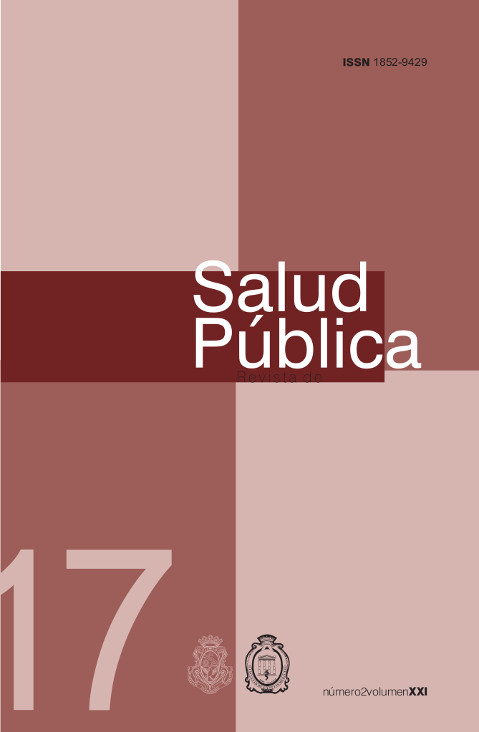FERTILITY DECLINE AND CHANGES IN UNMET NEED FOR FAMILY PLANNING IN COUNTRIES OF LATIN AMERICA AND THE CARIBBEAN
DOI:
https://doi.org/10.31052/1853.1180.v21.n2.16848Keywords:
Family planning, unmet need, fertility, contraceptive use.Abstract
Abstract Since the 1960s, fertility levels dropped sharply in countries of Latin America and the Caribbean (LAC). While the classical demographic transition theory attributes this decline to economic development, the downward trends in the region are better explained by the increasing use of birth control technologies. The aim of this research is to examine changes of unmet need for family planning in eight countries of LAC and determine to what extent variations in unmet need have contributed to achieve lower fertility levels from 1990 to the present. Data was derived from Demographic and Health Surveys and Reproductive Health Surveys nationally representative. Based on the revised definition of unmet need used to monitor the MDG5, this article presents a descriptive analysis of changes in unmet need in each country and analyses the relationship between fertility decline and unmet need through regression analysis. Results show that all countries record decreasing percentages of unmet need over time and that fertility decline is positively associated with unmet need.
Downloads
References
BONGAARTS, J. (2002) The End of the Fertility Transition in the Developed World, Population and Development Review, 28 (3): 419–443
BONGAARTS, J. (2008) Fertility Transitions in Developing Countries: Progress or Stagnation? Studies in Family Planning, 39 (2): 105-110
BRADLEY, S. E. K.; Casterline, J. B. (2014) Understanding Unmet Need: History, Theory, and Measurement, Studies in Family Planning, 45 (2): 123–150
BRADLEY, S. E. K.; Croft, T.; Fishel, J.; Westoff, C. (2012) Revising Unmet Need for Family Planning, DHS Analytical Studies, 25, Calverton, MD: ICF International
CASTERLINE, J.B. (2001) Diffusion Processes and Fertility Transition, National Research Council (US) Committee on Population, Casterline J.B., editor. Washington DC: National Academies Press
CASTERLINE, J. B.; El?Zeini, L.O. (2014) Unmet need and fertility decline: A Comparative Perspective on Prospects in Sub-Saharan Africa, Studies in Family Planning 45 (2): 227?245
CASTRO MARTÍN, T.; JUÁREZ, F. (1995) La Influencia de la Educación de la Mujer sobre la Fecundidad en América Latina: En Busca de Explicaciones, Perspectivas Internacionales en Planificación Familiar, special issue
CHACKIEL, J. (2004) La dinámica demográfica en América Latina, Serie Población y Desarrollo, 52, CEPAL/CELADE
DI CESARE, M. (2007) Patrones emergentes en la fecundidad y la salud reproductiva y sus vínculos con la pobreza en América Latina y el Caribe, Serie Población y Desarrollo, 72, UNFPA/CELADE
ECLAC (2013) “Social Panorama of Latin America”, Santiago: ECLAC
ECLAC (2015) Long term population estimates and projections 1950-2100, Available at: http://www.cepal.org/en/long-term-population-estimates-and-projections-1950-2100
FEYISETAN, B.; CASTERLINE, J. (2000) Fertility Preferences and Contraceptive Change in Developing Countries, International Family Planning Perspectives, 26(3): 100-109
MBOUP, G.; Saha, T. (1998) Fertility Levels, Trends, and Differentials, DHS Comparative Studies, 28, Calverton, Maryland, USA: Macro International
POPULATION COUNCIL (2015) Conceptualizing and Measuring Unintended Pregnancy and Birth: Moving the Field Forward, STEP UP Meeting Report. Accra: Population Council
SCHKOLNIK, S.; CHACKIEL, J. (2004) Los sectores rezagados en la transición de la fecundidad en América Latina, Revista de la CEPAL, 83, 2004
SCHOUMAKER, B. (2004) Poverty and Fertility in Sub-Saharan Africa: Evidence from 25 countries, Population Association of America Meeting, Boston, April 1-3, Available at: http://faculty.ksu.edu.sa/drzeinab/Library/my%20site%201/p1%20(10).pdf
SEDGH, G.; Ashford, L.S.; Hussain, R. (2016) Unmet Need for Contraception in Developing Countries: Examining Women’s Reasons for Not Using a Method, New York: Guttmacher Institute, Available at:
UNFPA; Guttmacher Institute (2014) Adding It Up 2014: The Costs and Benefits of Investing in Sexual and Reproductive Health, Available at:
http://www.unfpa.org/sites/default/files/pub-pdf/Adding%20It%20Up-Final-11.18.14.pdf
ZAVALA DE COSÍO, M.A. (1995) Dos Modelos de Transición Demográfica en América Latina, Perfiles Latinoamericanos, 6, June
Downloads
Published
Issue
Section
License
Copyright (c) 2017 Escuela de Salud Pública y Ambiente. Facultad de Ciencias Médicas. Universidad Nacional de Córdoba

This work is licensed under a Creative Commons Attribution-NonCommercial 4.0 International License.
Authors who publish with this journal agree to the following terms:
- Authors retain copyright and grant the journal right of first publication with the work simultaneously licensed under a Creative Commons Attribution License which allows the work to be copied, distributed, exhibited and interpreted as long as it is not done for commercial purposes.
- Authors are able to enter into separate, additional contractual arrangements for the non-exclusive distribution of the journal's published version of the work (e.g., post it to an institutional repository or publish it in a book), with an acknowledgement of its initial publication in this journal.
- Authors are permitted and encouraged to post their work online (e.g., in institutional repositories or on their website) after the publication process. (See The Effect of Open Access). (See The Effect of Open Access).







